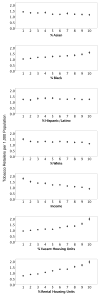Inequalities in tobacco outlet density by race, ethnicity and socioeconomic status, 2012, USA: results from the ASPiRE Study
- PMID: 28249990
- PMCID: PMC5458784
- DOI: 10.1136/jech-2016-208475
Inequalities in tobacco outlet density by race, ethnicity and socioeconomic status, 2012, USA: results from the ASPiRE Study
Abstract
Background: Evidence of racial/ethnic inequalities in tobacco outlet density is limited by: (1) reliance on studies from single counties or states, (2) limited attention to spatial dependence, and (3) an unclear theory-based relationship between neighbourhood composition and tobacco outlet density.
Methods: In 97 counties from the contiguous USA, we calculated the 2012 density of likely tobacco outlets (N=90 407), defined as tobacco outlets per 1000 population in census tracts (n=17 667). We used 2 spatial regression techniques, (1) a spatial errors approach in GeoDa software and (2) fitting a covariance function to the errors using a distance matrix of all tract centroids. We examined density as a function of race, ethnicity, income and 2 indicators identified from city planning literature to indicate neighbourhood stability (vacant housing, renter-occupied housing).
Results: The average density was 1.3 tobacco outlets per 1000 persons. Both spatial regression approaches yielded similar results. In unadjusted models, tobacco outlet density was positively associated with the proportion of black residents and negatively associated with the proportion of Asian residents, white residents and median household income. There was no association with the proportion of Hispanic residents. Indicators of neighbourhood stability explained the disproportionate density associated with black residential composition, but inequalities by income persisted in multivariable models.
Conclusions: Data from a large sample of US counties and results from 2 techniques to address spatial dependence strengthen evidence of inequalities in tobacco outlet density by race and income. Further research is needed to understand the underlying mechanisms in order to strengthen interventions.
Keywords: Health inequalities; PUBLIC HEALTH POLICY; SMOKING; Tobacco.
Published by the BMJ Publishing Group Limited. For permission to use (where not already granted under a licence) please go to http://www.bmj.com/company/products-services/rights-and-licensing/.
Figures
Similar articles
-
The association between the density of retail tobacco outlets, individual smoking status, neighbourhood socioeconomic status and school locations in New South Wales, Australia.Spat Spatiotemporal Epidemiol. 2015 Jan;12:1-7. doi: 10.1016/j.sste.2014.09.001. Epub 2014 Oct 5. Spat Spatiotemporal Epidemiol. 2015. PMID: 25779904
-
The inequitable distribution of tobacco outlet density: the role of income in two Black Mid-Atlantic geopolitical areas.Public Health. 2016 Jul;136:35-40. doi: 10.1016/j.puhe.2016.02.032. Epub 2016 Apr 10. Public Health. 2016. PMID: 27076440 Free PMC article.
-
The importance of income in the link between tobacco outlet density and demographics at the tract level of analysis in New Jersey.J Ethn Subst Abuse. 2010;9(4):249-59. doi: 10.1080/15332640.2010.522890. J Ethn Subst Abuse. 2010. PMID: 21161808
-
The Association Between Tobacco Outlet Density and Smoking Among Young People: A Systematic Methodological Review.Nicotine Tob Res. 2021 Jan 22;23(2):239-248. doi: 10.1093/ntr/ntz153. Nicotine Tob Res. 2021. PMID: 31433835 Free PMC article.
-
Exploring associations of population characteristics and tobacco and vape retailer density and proximity in Australia: a scoping review.Tob Control. 2025 May 15;34(3):361-368. doi: 10.1136/tc-2024-058760. Tob Control. 2025. PMID: 38969498
Cited by
-
Longitudinal Associations Between Changes in Cigarette Smoking and Alcohol Use, Eating Behavior, Perceived Stress, and Self-Rated Health in a Cohort of Low-Income Black Adults.Ann Behav Med. 2022 Jan 1;56(1):112-124. doi: 10.1093/abm/kaab029. Ann Behav Med. 2022. PMID: 33970236 Free PMC article.
-
Sociodemographic Disparities in Tobacco Retailer Density in the United States, 2000-2017.Nicotine Tob Res. 2022 Jul 13;24(8):1291-1299. doi: 10.1093/ntr/ntac020. Nicotine Tob Res. 2022. PMID: 35079790 Free PMC article.
-
Neighbourhood inequities in the availability of retailers selling tobacco products: a systematic review.Tob Control. 2025 May 15;34(3):350-360. doi: 10.1136/tc-2024-058718. Tob Control. 2025. PMID: 38937098 Free PMC article.
-
Longitudinal analysis of tobacco and vape retail density in California.Tob Induc Dis. 2022 Oct 17;20:87. doi: 10.18332/tid/153506. eCollection 2022. Tob Induc Dis. 2022. PMID: 36317059 Free PMC article.
-
Current advances in research in treatment and recovery: Nicotine addiction.Sci Adv. 2019 Oct 16;5(10):eaay9763. doi: 10.1126/sciadv.aay9763. eCollection 2019 Oct. Sci Adv. 2019. PMID: 31663029 Free PMC article. Review.
References
-
- Center for Public Health Systems Science. [Accessed October 3, 2014];Point-of-Sale Report to the Nation: The Tobacco Retail and Policy Landscape. 2014 http://cphss.wustl.edu/Products/Documents/ASPiRE_2014_ReportToTheNation.pdf.
-
- Halonen JI, Kivimaki M, Kouvonen A, et al. Proximity to a tobacco store and smoking cessation: a cohort study. Tob Control. 2014;23(2):146–151. - PubMed
Publication types
MeSH terms
Grants and funding
LinkOut - more resources
Full Text Sources
Other Literature Sources

